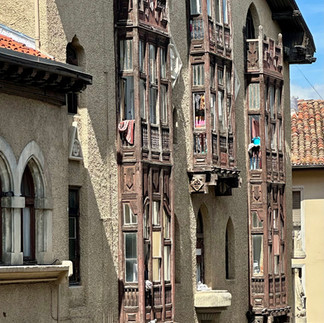After a 3 hours train trip north I arrived in the town of Vitoria-Gasteiz. (I have to say that the train system in Spain runs like clockwork and is so easy to use). Vitoria is the Basque capital and has a really interesting and well preserved medieval quarter with little corners, gardens and tree-lined boulevards. The city has 41sqm of green area per person. Being Saturday the place was humming with jazz bands, people having parties and crowded bars. Unfortunately I am only here for one night (in transit to San Sebastian) so will have to come back one day! But I did find a couple of specials today. The first was the monument to La batalla de Vitoria, a decisive battle which took place in the city on the 21 June 1813 during the Napoleonic wars. The allied troops, led by the Duke of Wellington defeated the French troops led by José Bonaparte himself which led to his definitive expulsion from the Iberian Peninsula. If it hadn't been for this victory it's pretty likely that I (and everyone else in Spain) would be speaking french!
The second interesting place I stumbled upon was the Memorial Centre for the Victims of Terrorism. Which sounds terrible but I found really fascinating. It told in incredible detail the three stages of Spanish terrorism from Franco's dictatorship, the ETA (Euskadi Ta Askatasuna) or the Basque Nationalists and then to GAL (Grupos Antiterroristas de Liberación; "Antiterrorist Liberation Groups") which were death squads illegally established by officials of the Spanish government during the Basque conflict to fight against ETA. It finally made a lot of sense as to why Australian's were not allowed (or discouraged from) travelling here in the 70's & 80's. And a bit like the situation I found in East Germany last year, possibly shaped the way Spain and Spanish people are today.
Finally, another city with an incomplete church: the cathedral was consecrated in 1969, but it is still not complete!! It is missing a portico and two towers that featured in the original design.


















Comments